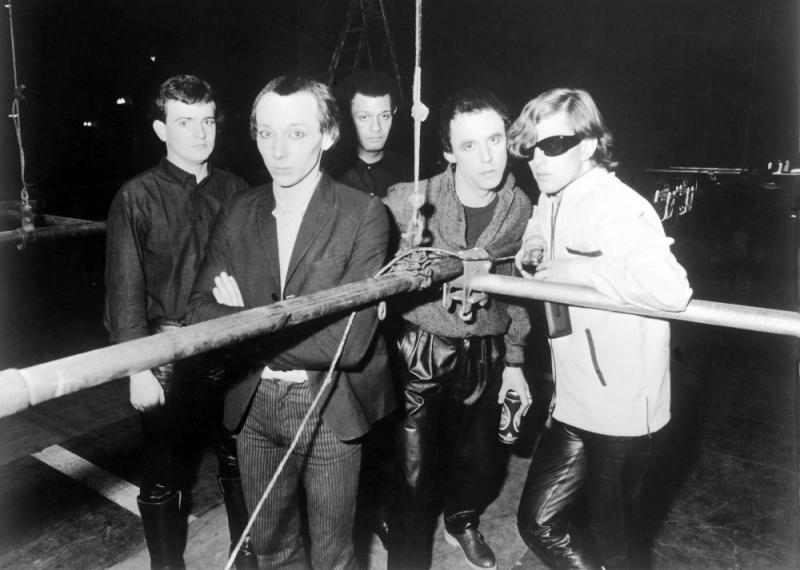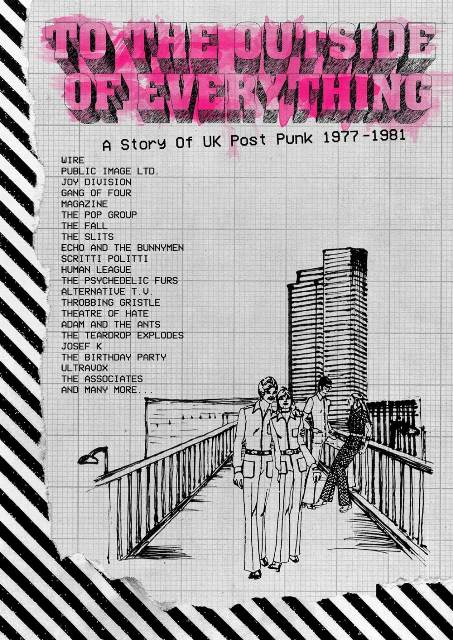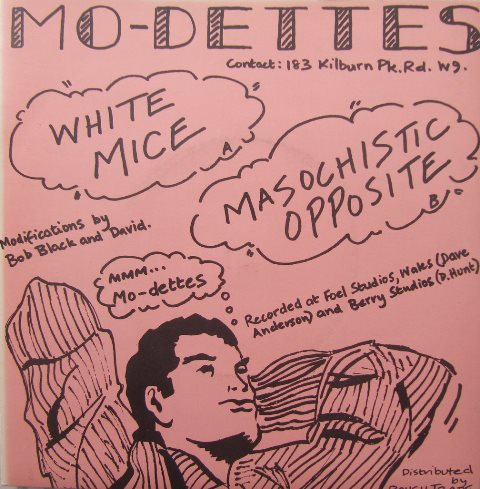Reissue CDs Weekly: To the Outside of Everything | reviews, news & interviews
Reissue CDs Weekly: To the Outside of Everything
Reissue CDs Weekly: To the Outside of Everything
British post-punk gets the box set treatment

Now that the 40th anniversaries of 1976 and 1977 as the years which birthed punk rock have themselves become history, surveyors of rock’s rich tapestry will inevitably turn to what came next. The year 1978 and what followed punk are easy targets and, in terms of labels, post-punk is accepted as a next wave out of the traps.
Proof of the five-CD set To the Outside of Everything's issues grappling with this amorphousness is acknowledged by its non-precise sub-title A Story Of UK Post Punk 1977–1981. There is no one story but, instead, fragmentation and attendant individualism. Goth, new romanticism, oi and Two Tone have as much claim to be post-punk as anything else – all were born or nurse-maided during 1977/78 and had clear ties with 1976/77 punk. But using a chronological designation as a stylistic description is a rocky road. The track-by-track annotation says Sad Lovers & Giants play “a mix of Post Punk and haunting electronic music.” Not even their music can answer the question of what this might mean.
 Nonetheless, a fair wodge of the 113 tracks draw from aesthetic building blocks which surfaced more-and-more during 1977 and 1978: scratchy, trebly funk-styled guitar; strangled or yelping vocals; rubbery bass guitar; dance-music derived or tribal drumming; borrowings from funk, jazz and reggae; the use of primitive electronics to define the nature of the song; lyrics of anomie.
Nonetheless, a fair wodge of the 113 tracks draw from aesthetic building blocks which surfaced more-and-more during 1977 and 1978: scratchy, trebly funk-styled guitar; strangled or yelping vocals; rubbery bass guitar; dance-music derived or tribal drumming; borrowings from funk, jazz and reggae; the use of primitive electronics to define the nature of the song; lyrics of anomie.
The knots tied working out what post-punk is or was are exemplified by Disc One’s opening track. Ultravox!’s “Young Savage” was issued in May 1977. It was the band’s first track to be released which reconfigured the band’s sound to reference punk. They were pre-punk and, especially with their 1978 work, were a major influence on Gary Numan’s Tubeway Army (also included). But seeing them as post-punk? They were, in the lyrics of the collection’s second track and title inspiration “outside of everything.”
That track is Magazine’s “Shot by Both Sides”, the January 1978 debut single from the band formed by Howard Devoto after he left Buzzcocks. It is, as per a lot of what’s collected on To the Outside of Everything, a fantastic record: one of the best ever made. It also – as, to a degree, “Young Savage” had – suggested where the energy and outsider narrative of punk could go next if recontextualised. This outlook defines how To the Outside of Everything is best taken: as a mix-and-match, chronologically sequenced document of punk-inspired individuals pushing forward and the subsequent and inevitable codification of musical tropes.
Amongst those collected who were active in 1977 and swiftly moving on musically were Adam & the Ants, Alternative TV, The Fall, John Lydon (in the form of Public Image Ltd), The Slits, Throbbing Gristle and Wire. Beyond them, most everyone who would be expected is here: including Gang of Four, Josef K, Joy Division, Killing Joke, The Monochrome Set, The Pop Group and Scritti Politti. XTC could be in these run downs but they are absent from the track list.
 To the Outside of Everything is more than a post-punk best-of. Art Objects, The Deep Freeze Mice and Occult Chemistry are not obvious choices due to their relative obscurity. Neither are former Buzzcock Steve Diggle, Mo-Dettes (pictured left, the sleeve of their To the Outside of Everything track "White Mice") and The Normal due to the nature of their music, as they explicitly drew from various pasts in a comparatively unmediated fashion (punk, Sixties pop and Krautrock). It is fascinating to conjure with the musical about-faces executed from what is heard here to generate mainstream success. Take a bow, Scritti Politti and Thompson Twins.
To the Outside of Everything is more than a post-punk best-of. Art Objects, The Deep Freeze Mice and Occult Chemistry are not obvious choices due to their relative obscurity. Neither are former Buzzcock Steve Diggle, Mo-Dettes (pictured left, the sleeve of their To the Outside of Everything track "White Mice") and The Normal due to the nature of their music, as they explicitly drew from various pasts in a comparatively unmediated fashion (punk, Sixties pop and Krautrock). It is fascinating to conjure with the musical about-faces executed from what is heard here to generate mainstream success. Take a bow, Scritti Politti and Thompson Twins.
As is inevitable with genre-type overviews, there are frustrations. Siouxsie & The Banshees, mentioned multiple times in the introductory essay, are missing. So are the important A Certain Ratio and Young Marble Giants. Less critically, the presence of Delta 5, The Lines, The Sound (their precursor outfit Second Layer is included) and The Visitors would have been good. Some of the dance/funk-oriented bands akin to APB would not have been missed and cheeky new wavers The Not Sensibles are a strange inclusion. To the Outside of Everything is a great listen though and unfolds unpredictably – as did the era it covers.
In that spirit, the opening essay makes no attempt to say when “post-punk” was first used (the two words are capitalised and unhyphenated throughout the package’s book). The music weekly Sounds floated the term “New Musick” as something apart from punk in late November 1977 when the writer Jane Suck posited a music which “probably all began with jazz or in the BBC workshop.” Bowie ’s Low, Kraftwerk, Eno, Robert Fripp, Space's synth-disco single “Magic Fly” and The Velvet Underground were her precursors.
 On the same page as Suck's analysis, Jon Savage suggested a raft of emerging bands were unafraid to show their roots. He also identified “harsh urban scrapings/controlled white noise/massively accented drumming.” The paper's ensuing articles were on Devo, Eno, Kraftwerk, The Residents and Throbbing Gristle (pictured right, the sleeve of their To the Outside of Everything track "United"). “New Musick” did not catch on but post-punk would. Hugely amusingly, that same issue of Sounds also included a contrasting retrospective on pub rock, explaining the roots of Elvis Costello, Ian Dury and other recent second and third-wind successes.
On the same page as Suck's analysis, Jon Savage suggested a raft of emerging bands were unafraid to show their roots. He also identified “harsh urban scrapings/controlled white noise/massively accented drumming.” The paper's ensuing articles were on Devo, Eno, Kraftwerk, The Residents and Throbbing Gristle (pictured right, the sleeve of their To the Outside of Everything track "United"). “New Musick” did not catch on but post-punk would. Hugely amusingly, that same issue of Sounds also included a contrasting retrospective on pub rock, explaining the roots of Elvis Costello, Ian Dury and other recent second and third-wind successes.
As to post-punk’s entry point into pop’s lexicon, who knows? Suggestions are welcome. Even Simon Reynolds, in his book Rip it Up and Start Again, did not pinpoint when it was first used.
While To the Outside of Everything is as thought provoking as it ought to be, there are problems which are nothing to do with interpretive viewpoints. Echo & The Bunnymen’s "The Pictures on my Wall” is annotated as the Zoo Records’ single version of the song: it is not, it is the re-recording from their debut album. The Monochrome Set’s “Eine Symphonie Des Grauens” and The Pop Group’s “We Are All Prostitutes” are not the single versions either.
There are frequent temporal mismatches between the pictures of bands in the accompanying book and the tracks included: the image of Theatre of Hate has Bully Duffy in the line-up yet he joined after the track included ("Rebel Without a Brain") and the recording of the ensuing album; the New Order picture is from the “Perfect Kiss” promo video rather than from around the time of “Ceremony”, the track included; a later line-up of Teardrop Explodes is seen to that which recorded “Sleeping Gas”. There are more. Also, amongst the typos: Modern Eon’s album was Fiction Tales not Fictional Tales and the label which issued a Dif Juz cassette was Presently Surprised not Pleasantly Surprise.
Manifestly, To the Outside of Everything is not the definitive statement on the post-punk era. It could not be. Nothing could be, as the sub-title acknowledges. It is, though, a bold, stimulating and frequently thrilling testament to an era when the strictures of genre definitions were shrugged off with aplomb. Niggles about the various slip-ups and the absence of the Banshees and Young Marble Giants aside, it’s hard to imagine it being bettered.
- Next week: Butterfly Child’s 1993 dub/shoegazing album Onomatopoeia
- Read more reissue reviews on theartsdesk
Explore topics
Share this article
more New music
 theartsdesk on Vinyl: Record Store Day Special 2024
Annual edition checking out records exclusively available on this year's Record Store Day
theartsdesk on Vinyl: Record Store Day Special 2024
Annual edition checking out records exclusively available on this year's Record Store Day
 Album: Jonny Drop • Andrew Ashong - The Puzzle Dust
Bottled sunshine from a Brit soul-jazz team-up
Album: Jonny Drop • Andrew Ashong - The Puzzle Dust
Bottled sunshine from a Brit soul-jazz team-up
 Album: Pearl Jam - Dark Matter
Enduring grunge icons return full of energy, arguably their most empowered yet
Album: Pearl Jam - Dark Matter
Enduring grunge icons return full of energy, arguably their most empowered yet
 Album: Paraorchestra with Brett Anderson and Charles Hazlewood - Death Songbook
An uneven voyage into darkness
Album: Paraorchestra with Brett Anderson and Charles Hazlewood - Death Songbook
An uneven voyage into darkness
 theartsdesk on Vinyl 83: Deep Purple, Annie Anxiety, Ghetts, WHAM!, Kaiser Chiefs, Butthole Surfers and more
The most wide-ranging regular record reviews in this galaxy
theartsdesk on Vinyl 83: Deep Purple, Annie Anxiety, Ghetts, WHAM!, Kaiser Chiefs, Butthole Surfers and more
The most wide-ranging regular record reviews in this galaxy
 Album: EMEL - MRA
Tunisian-American singer's latest is fired with feminism and global electro-pop maximalism
Album: EMEL - MRA
Tunisian-American singer's latest is fired with feminism and global electro-pop maximalism
 Music Reissues Weekly: Congo Funk! - Sound Madness from the Shores of the Mighty Congo River
Assiduous exploration of the interconnected musical ecosystems of Brazzaville and Kinshasa
Music Reissues Weekly: Congo Funk! - Sound Madness from the Shores of the Mighty Congo River
Assiduous exploration of the interconnected musical ecosystems of Brazzaville and Kinshasa
 Ellie Goulding, Royal Philharmonic Concert Orchestra, Royal Albert Hall review - a mellow evening of strings and song
Replacing dance beats with orchestral sounds gives the music a whole new feel
Ellie Goulding, Royal Philharmonic Concert Orchestra, Royal Albert Hall review - a mellow evening of strings and song
Replacing dance beats with orchestral sounds gives the music a whole new feel
 Album: A Certain Ratio - It All Comes Down to This
Veteran Mancunians undergo a further re-assessment and reinvention
Album: A Certain Ratio - It All Comes Down to This
Veteran Mancunians undergo a further re-assessment and reinvention
 Album: Maggie Rogers - Don't Forget Me
Rogers continues her knack for capturing natural moments, embracing a more live sound
Album: Maggie Rogers - Don't Forget Me
Rogers continues her knack for capturing natural moments, embracing a more live sound
 theartsdesk at Tallinn Music Week - art-pop, accordions and a perfect techno hideaway
A revived sense of civilisation thanks to dazzlingly diverse programming
theartsdesk at Tallinn Music Week - art-pop, accordions and a perfect techno hideaway
A revived sense of civilisation thanks to dazzlingly diverse programming
 Album: Lizz Wright - Shadow
Brilliant album from superlative vocalist
Album: Lizz Wright - Shadow
Brilliant album from superlative vocalist

Add comment